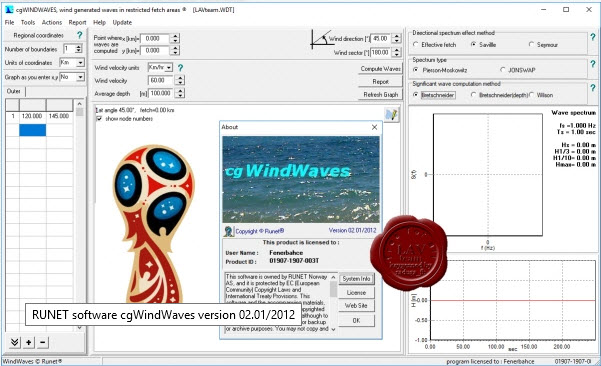RUNET software cgWindWaves version 02.01/2012


The wave forecasting methods are both empirical and theoretical. Many factors are involved in wave forecasting, especially in restricted fetch areas. The wave forecasting methods are based on semi-empirical relations (SMB methods, Sverdrup, Munk, and Bretschneider), which link the significant wave height Hs and significant wave period Ts to wind speed U, fetch length F, and water depth. The wave forecasting procedures is largely graphical, and laborious.
The program cgWindWaves gives an estimate of the waves in restricted fetch water regions. From the water region defined by its map, the mean wind direction and wind velocity, you obtain the significant wave height Hs, and wave period Ts, and a wave spectrum S(f). The wave prediction is based on the combination of various theories for wave forecasting, for directional effects, and wave spectra, which are implemented in the program. Application of the program is for regions where refraction is negligible.
The program implements the directional wave effects using either Seymour's, Savil's or effective fetch method. The significant wave and period forecasting from the wind velocity and fetch is based on Bretschneider's or Wilson's method. For the wind energy Pierson-Moskowitz and JONSWAP spectra are used. All the data are in one main screen (water region, wind direction and velocity, selection of theories), and the forecasted wave characteristics, spectrum and time series sample, are shown immediately
The program cgWindWaves gives an estimate of the waves in restricted fetch water regions. From the water region defined by its map, the mean wind direction and wind velocity, you obtain the significant wave height Hs, and wave period Ts, and a wave spectrum S(f). The wave prediction is based on the combination of various theories for wave forecasting, for directional effects, and wave spectra, which are implemented in the program. Application of the program is for regions where refraction is negligible.
The program implements the directional wave effects using either Seymour's, Savil's or effective fetch method. The significant wave and period forecasting from the wind velocity and fetch is based on Bretschneider's or Wilson's method. For the wind energy Pierson-Moskowitz and JONSWAP spectra are used. All the data are in one main screen (water region, wind direction and velocity, selection of theories), and the forecasted wave characteristics, spectrum and time series sample, are shown immediately
4MB
*
